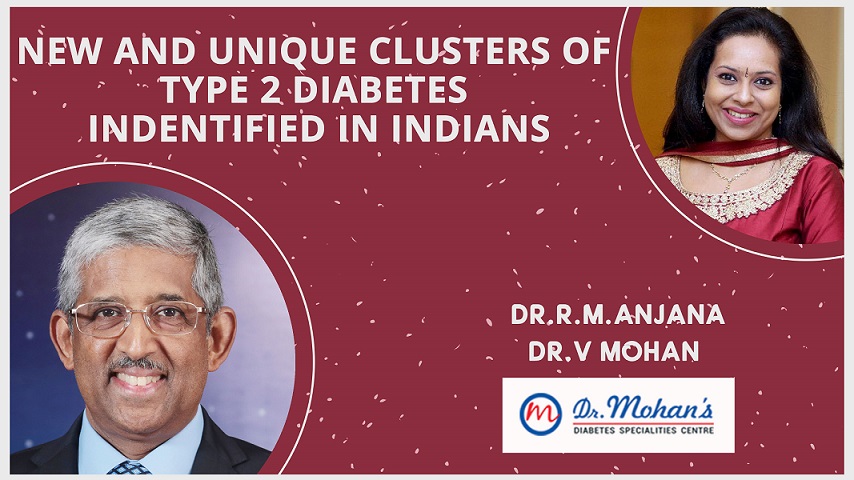A recent study entitled ‘Novel subgroups of type 2 diabetes and their association with microvascular outcomes in an Asian Indian population: a data-driven cluster analysis – The INSPIRED STUDY, was published online in BMJ Open Diabetes Research and Care on August 18, 2020. This project, called as the INSPIRED study is a collaborative project between the Madras Diabetes Research Foundation and Dr. Mohan’s Diabetes Specialities Centre, Chennai and the Division of Population, Health and Genomics, and the Division of Cardiovascular and Diabetes Medicine, University of Dundee, School of Medicine, Dundee, Scotland, UK. This research was funded by the National Institute for Health Research (NIHR).
Background of the study:
What are the salient features of this study?
- Recently five distinct “clusters” of individuals with diabetes with significantly different characteristics have been identified in a Scandinavian (White Caucasian) population, based on five parameters representing the clinical presentation as well as the presence of insulin resistance and beta-cell dysfunction.These five subgroups were termed as Severe Autoimmune Diabetes (SAID), Severe Insulin Deficient Diabetes (SIDD), Severe Insulin Resistant Diabetes (SIRD), Mild Obesity-related Diabetes (MOD) and Mild Age Related Diabetes (MARD).
- Asian Indians (South Asians) represent an ethnic group with high predilection for developing type 2 diabetes; indeed, some of the largest increases in diabetes prevalence have been reported from the South Asian region.
- Type 2 diabetes in Asian Indians differs from that in white Caucasians in a number of significant ways and this referred to as the ‘Asian Indian Phenotype’
- The “Asian Indian Phenotype”, characterized by high levels of abdominal fat and increased insulin resistance even at low levels of body-mass index (BMI), has been postulated as the main reason for this increased propensity to develop type 2 diabetes at younger age. Recent studies from our group suggest that beta-cell dysfunction occurs quite early and rapidly in Asian Indians.
- For the first time in India (and South Asia), clustering of diabetes was done on 19,084 individuals with type 2 diabetes using eight clinically relevant variables (age at diagnosis, BMI, waist circumference, HbA1c, triglycerides, HDL cholesterol and C-peptide fasting and stimulated) and published in BMJ Open Diabetes Research & Care.
What are the novel findings from this study?
- Data for this analysis was obtained from the diabetes electronic medical records (DEMR) of Dr.Mohan’s Diabetes Specialitites Centre, which represents one of the largest databases of diabetes patients in the world, with more than 450,000 diabetes patients
- We show for the first time, that type 2 diabetes in the Asian Indians can be classified into four distinct phenotypic clustersand this has important implications for prognosis and management of diabetes in Indians.
- Cluster 1 is referred to as SIDD (Severe Insulin Deficient Diabetes)] ,which was present in 2% of the patients and was characterized by the lowest BMI and waist circumference, as well as the lowest C-peptide (fasting and stimulated) levels. Beta cell function and insulin resistance were both low in this cluster. These individuals had the highest HbA1c values and were more likely to be using insulin compared to the other clusters. This group was more prone to diabetic retinopathy (eye) disease.
- Cluster 2 is a novel cluster described for first time and is referred to as IROD (Insulin Resistant Obese Diabetes). This comprised 25.9 % of the patients. These individuals had the highest BMI, waist circumference, highest C-peptide levels. Beta cell function and insulin resistance were also the highest for this cluster. Metabolic control was intermediate and this group was most prone to diabetic kidney disease.
- Cluster 3, another novel group identified in this population, is referred to as CIRDD (Combined Insulin Resistant and Deficient Diabetes) and constituted 12.1% of the study population. This group was characterized by the lowest age at onset. BMI and waist circumference were intermediate between SIDD and IROD. CIRDD had the highest triglyceride and lowest HDL cholesterol levels of all the four clusters. Beta cell function and insulin resistance values were also intermediate between SIDD and IROD, indicating coexistence of insulin deficiency and insulin resistance. Metabolic control tended to be poor; however, only 15% were on insulin. This group was prone to both retinopathy and diabetic kidney disease.
- Cluster 4 referred to as MARD (Mild Age-Related Diabetes) represented the most frequent cluster in this population (35·8%) and was characterized by later age at onset than other clusters. They were characterised by the highest HDL cholesterol, fairly preserved C-peptide values and the best metabolic control of all the 4 groups. This group had the least use of insulin and was much less prone to develop complications.
- The characteristics of the clusters did not differ when split by gender and duration of diabetes, which shows the stability of the clusters.
- Two of these subgroups (SIDD and MARD) correspond to the clusters identified in the Scandinavian populations, while the other two are novel subgroups (CIRDD and IROD) were unique to the Asian Indian population.
- These findings were also replicated in a representative population based ICMR-INDIAB study in India done across 15 Indian states, showing that the 4 Clusters identified are truly representative of India.
- The novel cluster “Combined Insulin Resistant and Deficient Diabetes” (CIRDD) is of particular importance as it is characterized by difficult-to-control hyperglycemia and increased risk of both diabetes eye and kidney disease.
What is the significance of this study?
- Classifying Asian Indians with type 2 diabetes into phenotypic clusters provides insights into the pathophysiological processes driving diabetes in this ethnic group which could help in predicting the risk of complications and in focusing more attention on individuals with the highest risk of developing complications of diabetes.
Quotes from authors:
Dr. R.M. Anjana, the Managing Director of Dr.Mohan’s Diabetes Specialities Centre and Vice President of Madras Diabetes Research Foundation and the first author of the study said, “Till now we have been treating all type 2 diabetes the same. This is the first time that different clusters of type 2 diabetes have been described in Indians and, hence, the paper is of great interest”.
Dr.V. Mohan, Chairman of Dr. Mohan’s Diabetes Specialities Centre and President of Madras Diabetes Research Foundation and the senior author of the study said that “These sub groups of type 2 diabetes have implications as far as treatment is concerned and the choice of anti-diabetic drugs, for eg. the severely dependent diabetes (SID) variety would probably respond better to sulfonylurea agents or secretagogues or may need insulin, whereas the insulin resistant variety would respond better to an insulin sensitizer like metformin.”
Dr.Colin Palmer, Chair, Department of Pharmacogenomics,School of Medicine, University of Dundee said “These findings appear to be unique to Indians as they differ significantly from the findings published earlier in the Scandinavian population”’.
Dr. Ewan Pearson, Professor, Diabetic Medicine, Division of Molecular and Clinical Medicine, School of Medicine, University of Dundee and the senior author of the study added, “We recently reported that Asians respond better to DPP4 inhibitors and SGLT2 inhibitors. The findings of this study confirm the greater insulin secretory defect and the younger age at onset of diabetes in South Asians”.




